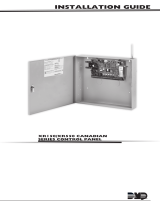Page is loading ...

Note: In step 2, it very important to remove electrical power from the circuits connected to
the relay strips, since external equipment may back-feed voltage through the relay strips!
CAUTION !
Removing and Replacing a Relay Strip
Farm Hand SCS™ w Back-Up
Part No. 4802-5063
Relay Strip Installation and Removal
1) Remove electrical power from the SCS™ panel.
2) Remove power from the equipment connected to the relay strip to be replaced.
3) Unplug the Stage harness cables from the relay board.
4) Verify the type of relay board. (See Inset A below)
5) Use needle nose pliers to pinch the tops of the mounting tabs to release the relay board.
6) Install new relay board by pressing evenly on the board near the mounting tabs.
7) Verify the Back-Up jumper settings.
8) Re-install the stage harness cables.
HIRED-HAND, INC. • 1733 Co Rd 68 • Bremen, AL 35033 • Phone 1-800-642-0123 • Fax 256-287-2000
FAIL-SAFE
strips are labeled at the top of the
board.
When replacing any Relay Strip
be sure to verify the type.
NORMALLY OPEN (N.O.)
strips are labeled at the bottom of
the board.
Inset A (Top)
(Bottom)
HEAT
COOL 3
COOL 2
COOL 1
RPK
COOL 3
COOL 2
COOL 1
HEAT
FAIL-SAFE RELAY STRIP
COOL 3
COOL 2
COOL 1
HEAT
B Crider
N.O.RELAY STRIP
Mounting Tab
Mounting Tab
SC
S
™
RELAY STRIPS
(Stage numbers shown
on relays)
To verify type of
Relay Strip see
Inset A below.
1
2
3
4 5
6
7
8
9
10
11
12
13
14
15
16
Stages 13 through 16 are
shipped as Fail-Safe.
WHAT ARE FAIL
-
SA
FE RELAY STRIPS ?
There are two types of Relay Strips used in the SCS™.
The Normally Open (N.O.) strip requires a signal from the
controller board in order to energize a stage of ventilation.
Should power be removed from the SCS™, the Normally
Open Relay board would not be able to energize a
ventilator. On the other hand, the Fail-Safe relay strip
would close each of the relays in the strip resulting in
energizing the ventilators in case of a controller power
failure.
/





